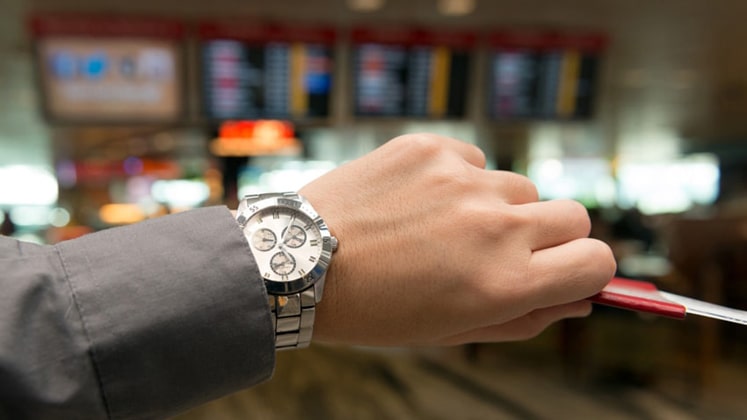
Pre-determined Motion Time System (PMTS) for sewing is a tool where hand eye co-ordination movements are broken down into micro elements like get, put, move, grasp, etc. Time required for each smallest hand movement are available from MTM (Methods Time Measurement) table which are worldwide standard for industrial repetitive manufacturing environment. Therefore, time required for any sewing operation can be decided calculated based on the hand movements that operator has to make while sewing the operation. Calculating the time of any sewing operation can be done by a PMTS practitioner without use of stopwatch and sometimes just by visualizing the operation. The synthetically calculated times are independent of operator’s rating and free from any error. Laszlo Szabo, MD, timeSSD along with Bela Marthi, ERP and Garment Industry Specialist explain how timeSSD can be used by a person with basic knowledge even without training.
For decades, use of PMTS systems for work measurement of sewing operations are crucial for setting the benchmark targets by manufacturers and buyers alike, who are also depending on different commercial PMTS system to set the labour costing. Although the primary source of time for a micro element comes from MTM table which is freely available in books and taught in every professional industrial engineering course, the industry specific macro created out of these micro elements are sold at premium by commercial PMTS solutions available specific to any industry.
There are several commercial brands of apparel manufacturing specific PMTS systems available in the world and most of them follow the standard model. Where apparel manufacturers are supposed to buy the solution (in the form of a software) first, the selected executives of the organization are then trained to use the PMTS solution by the PMTS provider. The interesting part is, software (solution) subscription is sold to an organization while the practitioner certificate is given to an individual. Eventually sometime or later when the executive leaves the organization, neither the organization can use the solution (as nobody else can use it), nor the executive can use the solution (as the executive does not have access to the software). This is a very common scenario in South East Asia.
Till date an atmosphere exists that learning of PMTS is very tough and to use the PMTS software, one must go through a formal training by the PMTS solution provider. Another important and interesting fact is that any individual can’t get himself/herself trained in any of the commercially available PMTS solutions (as the training can’t happen without buying the software, and the software is too costly for an individual to buy). These compound the reasons behind low adoption of PMTS system in South East Asia. In a departure to this age-old thinking, an interesting experiment was carried out recently using TimeSSD, a standard time data system, with Bachelor’s and Master’s students from NIFT across multiple campuses participating in the month-long experiment.
DataS is a Romania based PMTS solution provider offering its timeSSD® solution on cloud in SaaS model. The basic data code is same as the old time-tested SSD PMTS solution from Finland for apparel industry. Any user (anywhere in the world) can register and buy the credit and use it to analyze any sewing operation and calculate its standard minutes. The catch-line is ‘Any user’, while the existing industry understanding says that to use any commercial PMTS solution one has to go through rigorous training, how ‘anyone’ can use timeSSD solution without any training?
Even at the institute level, the students are given input on work measurement, but only the basic concept and working methodology about PMTS. Dr. Prabir Jana, NIFT Delhi was always on the lookout for certain ways to remove the anomaly and when he studied timeSSD, he realized that any student with good conceptual understanding will be able to use the software (without any training and support) because all the macro code were available (in the software) by means of video clippings. Under the experiment, students were asked to first observe any sewing operation in a garment factory and breakdown the operation to smallest element of hand movement. Each student who registered in the experiment got 150 TIT, which is equivalent to edit 150 SAM methods free credits to experiment with the software, to understand different codes related with hand motion of sewing operators with the help of video clippings provided by timeSSD. (1 TIT = 1 minute of elements selected from the timeSSD® database). To incentivize the experiment, timeSSD offered a bounty of total US $ 1000 in prizes to top three students who would be able to analyze the sewing operation correctly. The rule also stated that students can read books and available literature in public domain but can’t receive any guidance from faculty or SSD team regarding understanding of the code. It may be noted that software solution was specially modified for the student experiment with additional features like video upload.
Total 54 students showed interest, out of which 38 students registered. 18 students completed contest. The students worked on 565 operations in timeSSD, from which they saved in the system 117 methods and attached to 68 methods the corresponding video from the workplaces. 56 per cent of the students who completed the contest didn’t have any contact with the timeSSD team, completed their tasks without any question addressed to the helpdesk.
Of the total e-mails addressed to the timeSSD helpdesk, most of them were related to the registration process, the unique cooperation features included in timeSSD, and the dedicated video upload included in the software only for this experiment. While only few mails were software related which were politely denied. And the rest were confirmation and thanks mail.
Comparative analysis of seven different operations done by seven different students are shown in detail (Table 1) to explain how students fared in utilizing the software solutions. The TST time arrived by students and correctly analysed by time SSD expert reveals that students had overestimated the time in 3 cases and underestimated the time in 4 cases. The maximum variation ranges from +9.2 per cent to -16.2 per cent. While identifying number of elements of the operations, the variation ranges from +20.0 per cent to -14.3 per cent. Although the minimum and maximum difference between the student’s solution and timeSSD solution was -14.3 per cent and 20 per cent respectively, the median difference of TST and SAM between students and timeSSD time and motion studies is 7 per cent, and 13 per cent is the difference between number of timeSSD elements used, which demonstrates from our point of view, that timeSSD can be used by the persons with knowledge of time and motions study.
Table 1 (Comparative analysis of Student and timeSSD expert)
| Operation name | Results | Student | timeSSD | Student | timeSSD | Student | timeSSD | Student | timeSSD | Student | timeSSD | Student | timeSSD | Student | timeSSD | Variation % |
| Pick up & position | Position | Machine Time | Handling | Scissor & Snipper | Dispose & Finishing | Total | ||||||||||
| Main Label Attach | TST | 0.064 | 0.14 | 0.059 | 0.016 | 0.072 | 0.096 | 0.072 | 0.1 | 0.028 | 0 | 0.048 | 0 | 0.343 | 0.352 | 0.03 |
| No. elements | 2 | 7 | 3 | 1 | 5 | 5 | 4 | 7 | 1 | 0 | 1 | 0 | 16 | 20 | 0.2 | |
| Tack front pocket side & waist + attach single fly(j-piece) to the left | TST | 0.089 | 0.067 | 0.241 | 0.218 | 0.131 | 0.131 | 0.061 | 0.083 | 0 | 0 | 0.086 | 0.052 | 0.609 | 0.55 | -0.11 |
| No. elements | 3 | 3 | 18 | 12 | 8 | 8 | 7 | 10 | 0 | 0 | 2 | 2 | 38 | 35 | -0.09 | |
| Centre Back Attachment of Lower Dress (Skirt) | TST | 0.078 | 0.101 | 0.136 | 0.103 | 0.105 | 0.105 | 0.043 | 0.076 | 0 | 0 | 0.007 | 0.004 | 0.369 | 0.39 | 0.05 |
| No. elements | 2 | 3 | 5 | 4 | 4 | 4 | 3 | 6 | 0 | 0 | 1 | 1 | 15 | 18 | 0.17 | |
| Polo shirt left placket button hole | TST | 0.028 | 0 | 0.031 | 0.049 | 0.225 | 0.21 | 0.018 | 0 | 0 | 0 | 0.004 | 0.004 | 0.305 | 0.263 | -0.16 |
| No. elements | 1 | 0 | 2 | 3 | 3 | 3 | 1 | 0 | 0 | 0 | 1 | 1 | 8 | 7 | -0.14 | |
| Collar Run Stitch | TST | 0.029 | 0.034 | 0.101 | 0.133 | 0.153 | 0.142 | 0.036 | 0.036 | 0 | 0.028 | 0.078 | 0.052 | 0.397 | 0.425 | 0.07 |
| No. elements | 1 | 1 | 5 | 5 | 7 | 6 | 2 | 2 | 0 | 1 | 3 | 2 | 18 | 17 | -0.06 | |
| Shoulder join | TST | 0.126 | 0.157 | 0.116 | 0.116 | 0.029 | 0.029 | 0 | 0.015 | 0.102 | 0.102 | 0.076 | 0.076 | 0.449 | 0.495 | 0.09 |
| No. elements | 3 | 4 | 6 | 6 | 2 | 2 | 0 | 1 | 2 | 2 | 1 | 1 | 14 | 16 | 0.13 | |
| Attach front pocket to body | TST | 0.119 | 0.132 | 0.073 | 0.073 | 0.07 | 0.07 | 0.02 | 0.02 | 0 | 0 | 0.026 | 0.026 | 0.308 | 0.321 | 0.04 |
| No. elements | 4 | 4 | 5 | 5 | 4 | 4 | 3 | 3 | 0 | 0 | 1 | 1 | 17 | 17 | 0 | |
Further, the timeSSD time and stopwatch time (total cycle-time from pick to dispose) for twenty different operations done by one student reveal (Table 2) that average variance percent is only -1 per cent, which means (on an average, the students overestimated the cycle time by only 1 per cent).
Table 2 (Comparative time estimation by stopwatch and time SSD)
| S.No. | Sewing Operation | Stopwatch avg. Observed time(without multiplied by rating and no allowance added) | time-SSD TST Time( standard time without any allowance i.e. the normal/basic time based upon the PMTS study) | Variance % |
| 1 | Attach main label to waist band | 0.254 | 0.213 | -19% |
| 3 | Joining of inseam by felled seam | 0.519 | 0.525 | 1% |
| 4 | Tack front pocket side & waist + attach single fly | 0.613 | 0.609 | -1% |
| 5 | Attach zipper & top stitch j-form | 0.291 | 0.286 | -2% |
| 6 | Attach double fly to zipper & attach left front to zipper | 0.266 | 0.321 | 17% |
| 7 | Attach front rise | 0.235 | 0.253 | 7% |
| 8 | Top stitch side seam | 0.497 | 0.504 | 1% |
| 9 | Attach front pockets to body | 0.344 | 0.386 | 11% |
| 10 | Turn & top stitch on front pocket mouth | 0.466 | 0.534 | 13% |
| 11 | Front pocket bag closing | 0.452 | 0.387 | -17% |
| 12 | Top stitch front pocket bag | 0.32 | 0.316 | -1% |
| 13 | Overlock single fly, double fly and front rise | 0.43 | 0.517 | 17% |
| 14 | S-fly shadow stitch | 0.174 | 0.139 | -25% |
| 15 | Attach care label, polybag & line-label | 0.265 | 0.278 | 5% |
| 16 | Attach back yoke | 0.261 | 0.281 | 5% |
| 17 | Side seam joining | 0.501 | 0.503 | 0% |
| 18 | Bottom hemming | 0.564 | 0.514 | -10% |
| 19 | Bartack at loops 21 nos. | 1.288 | 1.095 | -10% |
| 20 | Attach belt-loop to waist band 7 nos. | 0.349 | 0.418 | 17% |
| 21 | Attach waist band to body | 0.554 | 0.472 | -17% |
While the overall student’s feedback was overwhelmingly encouraging for the usefulness of the software and rich experience gained during the experiment, it can be safely assumed that the software can be used without any training. Some of the students gave very detailed and critical feedback on the software and probable additional feature to make the solution easy to use. A quote from a student’s feed-back e-mail sums it all, “TimeSSD as the redefined state of the art MTM-2 is no less than a gem for an I.E. personnel”.






